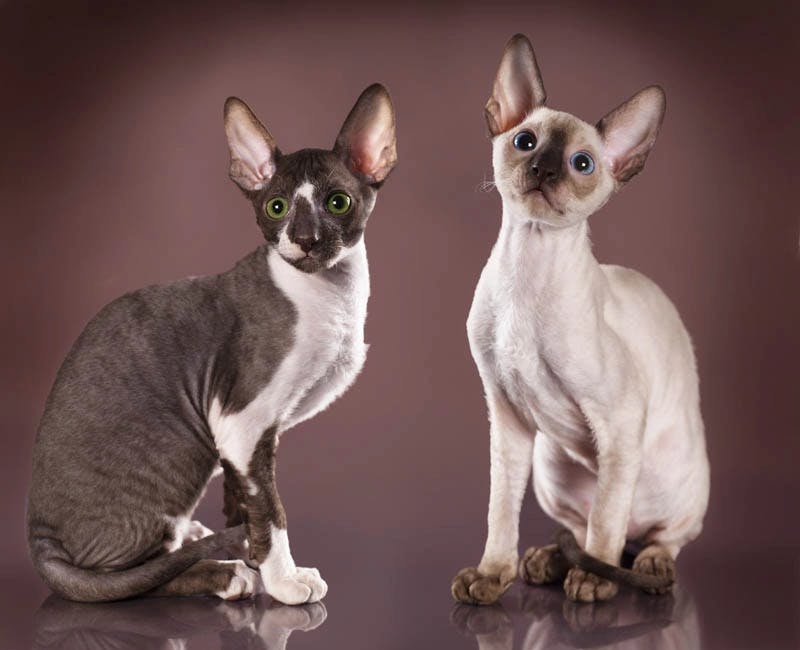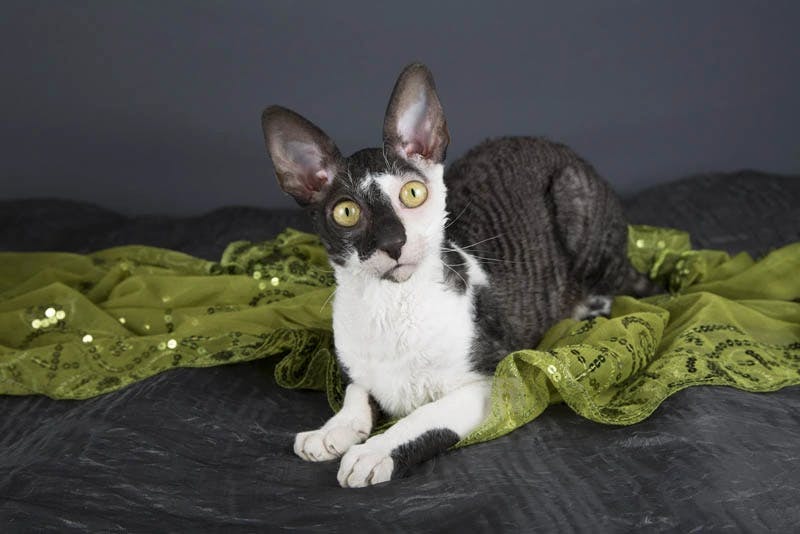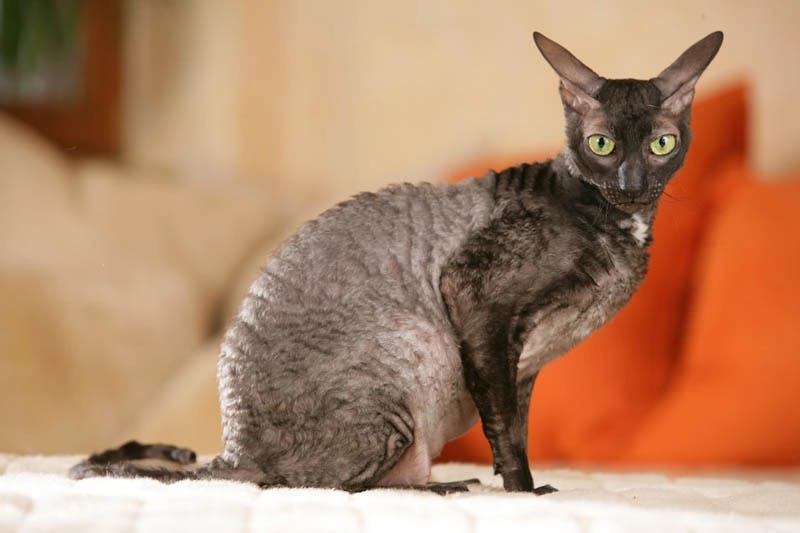Cornish Rex
A Cat with the Look of an Extraterrestrial
Cornish Rex
Antonia Cirjak - Last Updated on December 18th, 2021
Things you Should Know about the Cornish Rex
The Cornish Rex doesn’t appear to be very strong or even able to sustain itself without tender and protective care.
However, this is only because of the breed’s outward appearance. A thin layer of soft coat and bones that seem to protrude through the skin does seem ghoulish.
The way this cat looks is a direct outcome of unusual genetic mutation and sends a wrong message to those that like to judge a book by its cover. The truth is that the Cornish Rex cat is incredibly athletic, extremely fast, and enduring.

Appearance Matters. What does a Cornish Rex look like?
This is a fairly large cat with an unusually shaped head and oversized ears that sit high on the smallish head. The shape of their eyes almost reminds us of the way movies like to depict aliens. But there’s nothing extraterrestrial about this cat at all.
The fact is that this breed is actually very muscular and is perfectly built to do all sorts of acrobatics. The type of coat a Cornish Rex has is extremely light and doesn’t shelter the cat from extreme conditions.
This is why it’s best to provide warm indoor conditions. It will allow them to sustain their body temperature of 102 degrees, which is at the higher end of the spectrum for cats.
Don’t be surprised if you find your Cornish nestled on your favorite electronic device. They will seek out warm places.
The coat itself is actually an undercoat that’s incredibly silky to the touch and has a curly appearance. The curly Rex cat also sports unusual, crinkled whiskers.
Nothing about this cat is ordinary except maybe its weight. Cornish Rex kittens grow up to weigh up to 10 pounds if they’re male, while females typically stop at 7 pounds.
What is the difference between a Devon Rex and a Cornish Rex?
The main thing that differs between these two cat breeds is the way the genetic mutation has influenced their coats.
The Devon Rex has short and wavy guard hairs, which are basically the outer fur, while the Cornish Rex doesn’t have any guard hairs at all. Even though they generally look very similar, they are indeed entirely unrelated breeds.
What colors do the Cornish Rex cats come in?
Cornish Rex comes in a wide assortment of colors and patterns.
Here are some of the most popular ones:
- White
- Black
- Orange
- Chocolate
- Blue
- Cream
- Lilac
- Classic tabby
- Ticked tabby
- Smoke
- Tortoiseshell
It's all Personal. The Cornish Rex Temperament
When discussing the Cornish Rex’s personality, most people don't expect the breed to be curious and playful. Yet, they are eternally childlike in their mischievous ways.
This breed is very intelligent and motivated to explore the world. This sometimes translates to stealing a piece of your dinner even when you’re right there looking. Fun and games abound with this cat.
The Cornish Rex will also happily join an interactive game with their favorite persons, especially if it involves racing or flipping in the air and even fetching toys. Like most cats, they profoundly enjoy pushing objects from high shelving.
They also prefer someone to keep them company at all times. The Cornish cats are not big fans of being left alone. If you plan on being absent for more than a couple of hours, they will appreciate someone checking on them.

Caring for your Cornish Rex
The Cornish Rex’s coat is extremely low maintenance. This is great news for anyone wanting a cat but isn’t able to dedicate a lot of time to brushing or grooming in general.
The best tool to use with this type of thin and soft coat is a rubber brush. However, do keep in mind that the brushing should be very gentle and not excessive. Over-brushing can lead to hair damage that may be irreversible.
The big question people usually ask is: do Cornish Rex shed? They shed much less than typical domestic cats due to the curly, short coat that sits snuggly next to the skin.
When it comes to other grooming requirements, note that the breed does tend to get an oily discharge that needs tending to. The oil builds up around their toes and especially within the ears. Regular and gentle cleaning of these areas is highly recommended.
Do Cornish Rex cats need baths?
Yes, these cats require occasional baths due to secretions from oil glands in the skin. This is a normal process for all cat breeds, but the Cornish cannot count on their coat to absorb the oil since there isn’t much of it.
If you don’t clean the oily buildup regularly, it will pick up dirt from the environment and become a perfect breeding ground for bacteria.
A nice, warm bath once every week or two is sufficient to keep this under control.
Are Cornish Rex cats hypoallergenic?
While the lack of a lush, dense coat might imply that the Cornish Rex is also hypoallergenic, this isn’t true.
The main factor in triggering allergic reactions in people isn’t the coat length or the amount of shedding. The allergen is actually a protein called Fel d1 that is found in the oil glands, urine, and cat’s saliva.
This means that even though the Cornish doesn’t shed much, they can cause an allergic reaction in people with extreme sensitivities. However, the intensity of these reactions is reportedly low, which is good news for people with moderate or mild allergies.
The Health and Happiness of your Cornish Rex
The Cornish Rex has a relatively long lifespan that ranges from 11 to 15 years. There are also stories of Cornishe’s that have lived significantly longer than that, so we can confidently say that this is a breed with a zest for life.
It is also a healthy breed, aside from possible thickening of the heart (hypertrophic cardiomyopathy). This affects all cat breeds, including the Cornish Rex.
Breeders should not breed any individual cat that is proven to have HCM.
They are also prone to the luxation of the patella, where the kneecap might suddenly move out of its socket. This condition can be painful and can cause issues with walking.
However, the most common issue that your Cornish can suffer from is obesity. Keep your cat at a healthy weight to prevent any medical complications that might arise from this.
Where Can I Find the Best Cornish Rex Breeders?
These athletic cats can melt hearts with their curious look, so it makes sense that you would want one as your pet. Of course, you would want to get one from a reputable breeder.
To find the one that suits you, you can always check out our list of Cornish Rex breeders. The price of these cats averages between $800 and $1,200.
However, despite the price, getting your pet from a breeder will help you tremendously, as you will be able to avoid many health issues. You will be able to pick the pet you want, choose the right characteristics, and get a breed standard.

Feline History. Where does the Cornish Rex come from?
The Cornish Rex breed emerged in the 1950s in the United Kingdom due to a natural genetic mutation.
The litter in question had a unique kitten that was unusually slender with a small head and light, curly coat. The owners named him Kallibunker, and he came to be the first official representative of its breed.
The owner at the time decided to breed Kallibunker once he grew up. The breeding partner was his mother, and they produced two more kittens that fit the same description.
These two littermates arrived in the US in 1957, but only one of them survived the trip. The kitten that did survive ended up producing a litter of Cornish Rexes, which became the bedrock of this extraordinary breed in the US.
